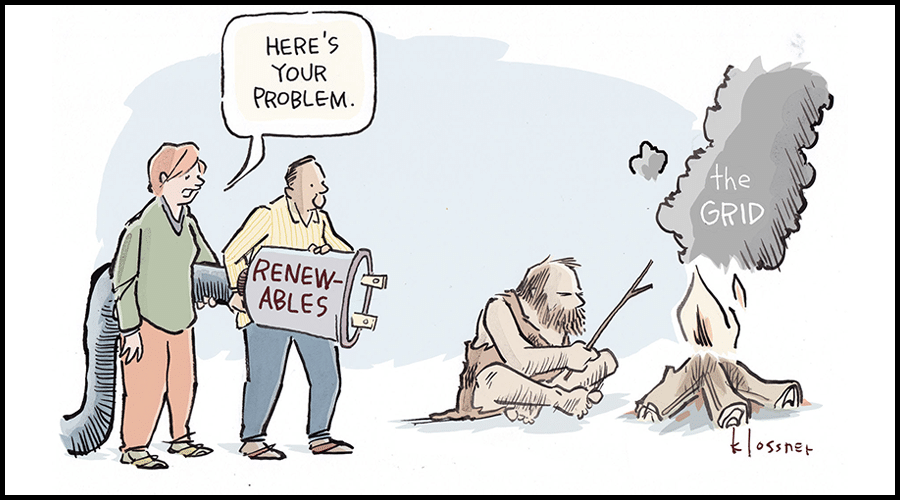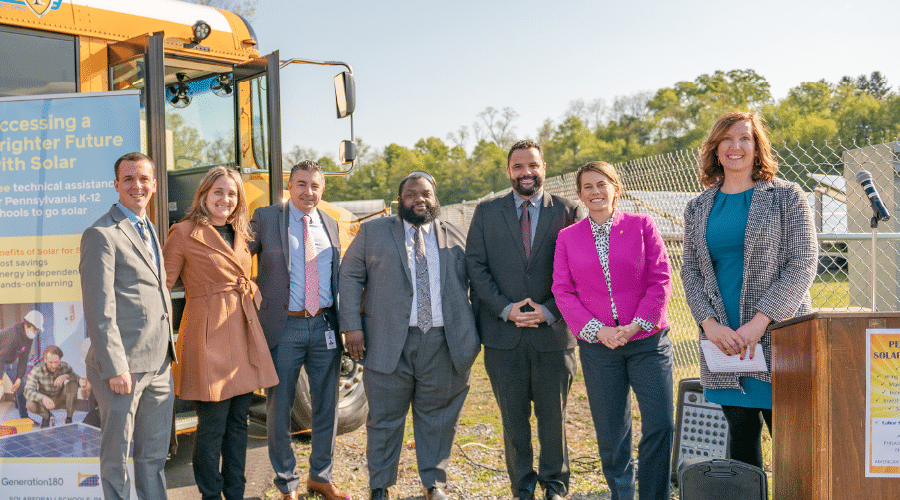In early September, the federal government released one of its most ambitious plans yet for the U.S. clean energy transition. The Department of Energy (DOE), in its Solar Futures Study, outlined a blueprint to power the country with a whopping 40 percent solar energy by 2035—a mere 14 years from now. This shift would require dramatically restructuring the electricity system and embracing a whole new perspective on how and where we get our energy, with the goal of eventually reaching a zero-carbon-emissions grid. But how realistic is this solar transition, especially given the short time horizon?
The amount of electricity that the DOE envisions as coming from solar alone in 2035 is more than American homes consume in total today, from all energy sources. To get to such a high solar share in the next 14 years, the U.S. would need to quadruple the amount of solar power that it adds to the grid every year, so that by 2035 around 1,000 gigawatts of installed solar capacity would be supplying our homes and workplaces. To put this in perspective, last year the U.S. installed 15 gigawatts of solar, for a cumulative total of 76 gigawatts. That itself was a record amount, and it represented just 3 percent of the country’s total electricity supply. So we’re talking a full-on solar explosion to get to 40 percent.
The good news is the DOE says it’s doable, and the benefits would be unquestionable. For one, we’d have a much cleaner power grid, significantly reducing both local pollution from fossil fuel power plants and the greenhouse gas emissions that contribute to climate change. The Solar Futures Study estimates that the health savings alone from reduced carbon emissions and improved air quality would reach $1.7 trillion—far more than the cost of making the entire transition to solar. We’d also transform our economy, with the push to solarize the grid employing up to 1.5 million people by 2035 (3 million if you include all clean energy technologies). And importantly, this could all happen without having to raise electricity prices, because of the savings from improvements in technologies.
And importantly, this could all happen without having to raise electricity prices…
Getting to 40 percent
It might sound too good to be true, but there’s actually a pretty clear pathway toward making it all happen—at least on paper. The crux of the solar (and wider clean energy) transition involves “electrifying everything”—that is, moving our transportation, home heating and cooling, and other key energy-consuming systems to run on electricity rather than carbon-intensive fuels like coal, oil, and natural gas. The key to reaping these benefits is powering the electricity supply itself with clean energy, including the envisioned large solar share, but also wind, nuclear, and other non-fossil energy sources.
This would require strong, targeted, and immediate decarbonization efforts across the economy. It would also require modernizing our lagging electricity grids to accommodate the variable nature of solar and wind energy—the wind doesn’t always blow and the sun doesn’t always shine. This means ramping up complementary solutions like advanced forecasting, large-scale energy storage (like the massive battery systems now being deployed in California and Florida) and the seamless integration of backup generation from other clean energy sources to ensure flexibility in grid operations.
Key considerations: economics and materials
From an economic perspective, the odds are in solar’s favor. The costs of solar generation have plummeted nearly 90 percent in the past decade, making it the cheapest and fastest-growing clean energy source. (Solar costs have jumped slightly since the pandemic due mainly to supply chain challenges, but this is considered temporary.) Everyone from school districts to government buildings to your next-door neighbor are jumping on the solar bandwagon, recognizing the cost savings. But these opportunities need to expand widely to support populations left behind by the clean energy revolution.
A more practical issue is whether the U.S. will have enough of the critical materials required for an ambitious solar ramp-up, including metals like aluminum, copper, zinc, and lithium, which are used in everything from solar panel frames to transmission cables to batteries. By one estimate, the demand for minerals for clean energy purposes could exceed the supply within a decade. Moreover, production of some metals is highly concentrated geographically—for example, 90 percent of the world’s lithium comes from just three countries—which could lead to price volatility and supply disruptions.
But even here, prospects seem reassuring. Research suggests that renewable power generation requires fewer materials than using fossil fuels, and the rising demand for certain metals and minerals would likely trigger a sharp increase in recycling. According to one study, recycling or repurposing solar panels at the end of their lifetime could unlock around 78 million tons of raw materials and other valuable components globally by 2050. There is also significant potential to use substitute metals for existing energy applications, like using aluminum to replace copper in electrical wiring.
The big wildcard
In sum, the barriers to getting to 40 percent solar aren’t economic, and they’re probably not related to the supply of materials. The big wild card is… drumroll… politics. Supportive policies will be critical in accelerating the clean energy transition (and overall decarbonization) and are necessary both to speed the deployment of technologies and reduce costs. In addition to providing incentives for clean energy, policies will have to dis-incentivize the continued use of fossil fuels (which we have been generously INcentivizing both directly and indirectly for over a century), including by putting limits on carbon emissions and building in the social cost of carbon. Without a strong mix of policies, models show that the U.S. wouldn’t be able to achieve a zero-carbon grid, instead reducing emissions only by 60 percent.
According to U.S. energy secretary Jennifer Granholm, the key decarbonization policies that the U.S. needs in order to get to 40 percent solar are “exactly what is laid out in the bipartisan Infrastructure Investment and Jobs Act and President Biden’s Build Back Better agenda.” The administration has set an ambitious and, importantly, measurable goal. But, as climate activist Bill McKibben recently noted, similar efforts have been tried before. As far back as 1979, President Carter tried to advance a goal of generating 20 percent of the U.S. energy supply from solar by the year 2000. Needless to say, it didn’t work out. The Biden team’s ongoing attempts to push through key parts of its agenda show just how hard it will be to get Congress to agree on big clean energy spending—despite the clear path forward.
We have the technical know-how, we have a clear path forward, and we have public support for a clean energy transition.
The political struggle is real, and so too is the urgency. As McKibben puts it so starkly, “2050 is not that far away, and yet a lot of damage can be done by then.” Whether it’s making efforts to recycle more critical materials, ramping up solar installations, or creating more incentives for everyday Americans to embrace clean energy, we need to get moving—now. Fortunately, we can take solace in the fact that at least some things are different now than in the 1970s. We have the technical know-how, we have a clear path forward, and we have public support for a clean energy transition. And, unlike in the 70s, we also have a strong economic case: consider that in 1977, a watt of solar PV power cost $77, compared to a mere 13 cents today—a drop of 600 percent). Of course, solar alone won’t save the planet, but it’ll get us a heck of a lot closer to our clean energy future. We just need to tackle those political speed bumps.
















